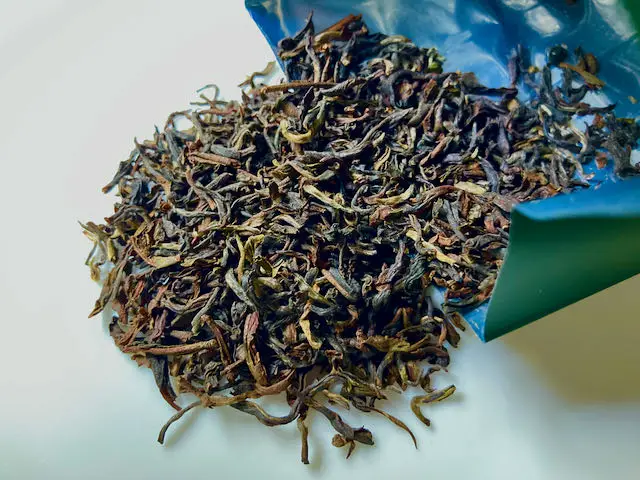
[Though we may receive a commission through affiliate links, our reviews are independent and unsolicited.]
Brewing loose-leaf tea, rather than bagged tea, is an increasingly popular way of preparing the world’s favorite beverage.
Loose-leaf teas have two key advantages. First, you can alter the strength of the brew by adjusting the amount of tea leaves you steep. If you drink bagged tea, you’re stuck with the amount of tea—and the sensory experience—trapped in a bag.
Another advantage is size, with loose-leaf generally made of larger pieces of whole plant leaf than tea inside bags. Size matters because, among many differences, tiny particles of tea release flavor compounds into hot water faster than large ones. You get a quick extraction from a tea bag, and it’s all over.
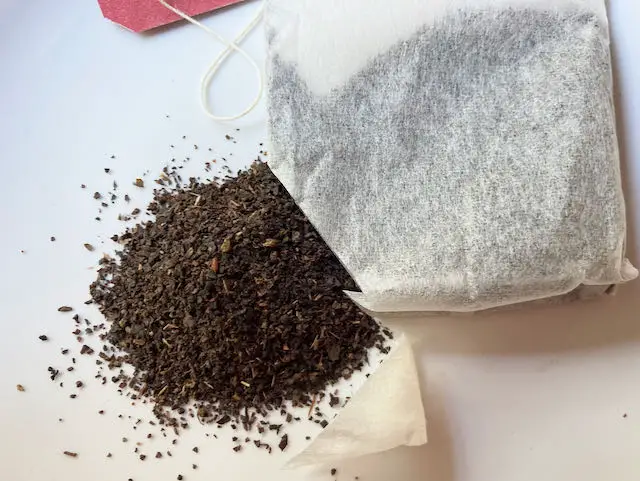
But with loose-leaf teas, the larger pieces release aroma and taste compounds more slowly. Instead of getting a quick blast of everything the tea offers, loose-leaf tea expresses its flavor and character gradually and with more complexity.
In short, loose-leaf gives us flexibility in how we experience tea. In my tea-craft enterprise, I only manufacture loose-leaf products because consumers appreciate the benefits of tea in its unrestricted, natural form.
Loose-leaf Tea Sounds Great. What’s the Catch?
As the American tea market grows, the discerning tea lover must be cautious. Some tea manufacturers sell low-quality loose-leaf, hoping to cash in on the craze.
At the same time, tea newcomers are overwhelmed by the sheer number of choices, making savvy buying decisions a challenge.
Is there a resolution to this tea conundrum?
The answer is an enthusiastic yes! The average tea is better today than ever, and here I’ll share my recommendations for the best loose-leaf teas on the market. I collect and study other tea makers’ products because it’s fun and sharpens my tea farming and processing skills.
You benefit from my continuing education with a list of the best loose-leaf teas!
How I Picked The Best Loose-leaf Teas
You’re on this page because you want to drink great tea. Many readers here are also just starting their tea journey and want guidance in choosing the best loose-leaf teas.
I’m happy to help, and here are the criteria I use to select tea for this list:
Let’s get started at the top with a tea that will be a surprise to many.
#1. Best Overall Loose-leaf Tea: Japanese Black Tea by Ocha & Co.
Japan is famous for its green teas but not its black teas. This is a shame because loose-leaf black tea from Japan is some of the finest black tea for the price I’ve ever sampled. It would be my daily tea if I lived there and didn’t grow my own.
My top recommendation is a handpicked and loose-leaf black tea by Ocha & Co. of Japan. They work hard to maintain high-quality, organic standards on their tea farm and production facilities. Ocha & Co. also monitor heavy metals and other toxins in their tea plants and soils.
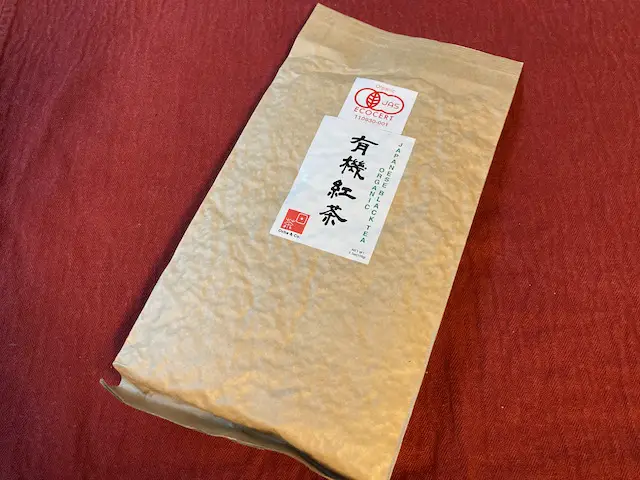
Without synthetic chemicals interfering with plant growth and self-defense, the true nature of the tea plant can emerge in your cup.
Processed in small batches, Ocha & Co. delivers a 3.5 oz (100g) vacuum-pressed packet for preserving flavor and easy shipping. The aroma of a freshly opened packet is deliciously fruity, like raspberry jam, and the dry leaves are dark brown and black with a tight twist from machine-driven rolling.
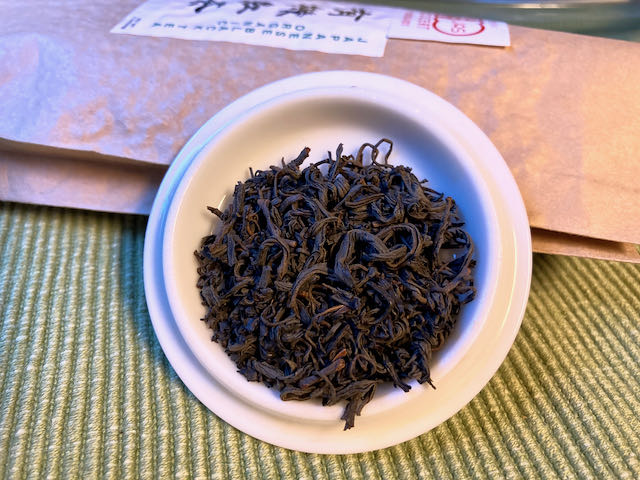
I steep about 2 teaspoons (4 g) of tea for 90 seconds in 200°F (93°C) water. The primary flavor tones are sweet and earthy, with minor notes of dried flowers and tart fruit. There’s no bitterness and just enough astringency to hold the flavor after you swallow the tea. And the mouthfeel is smooth and clean while nicely enduring after the sip.
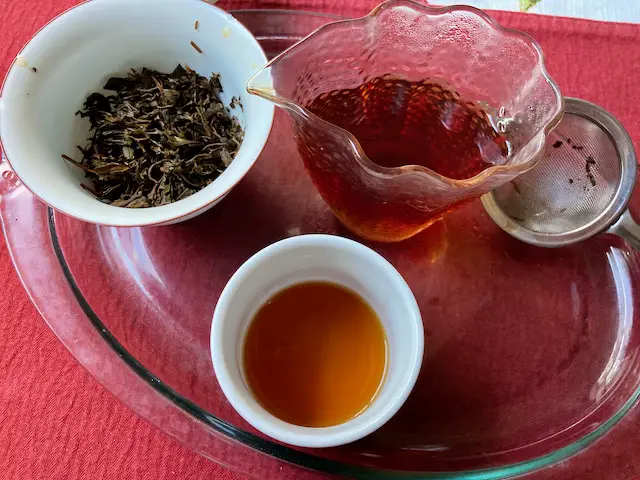
A second infusion for 120 seconds isn’t as strong as the first, but still pleasant.
This is a lovely loose-leaf tea for everyday enjoyment or for bringing out on special occasions. If I knew the manufacturing secret to Ocha & Co.’s black tea, I’d copy their recipe!
#2. Best Loose-leaf Breakfast Tea: English Breakfast Tea from Rishi Tea
You can’t go wrong with a loose-leaf breakfast tea to start your day.
Breakfast teas blend two or three different types of black tea that, together, have a flavor and mouthfeel distinct from each tea on its own. Breakfast teas are usually malty, robust, and have a smooth, lingering finish. The idea is to make a tea that pairs well with toast, cereal, sweeteners, and perhaps milk. Tea makers often prefer hearty, bold Assam black tea for the foundation of the blend, which they take the edge off with black tea from Ceylon, Kenya, or China.
The blend known as English Breakfast is the best-known breakfast tea and is produced by many manufacturers. I recommend English Breakfast tea from Rishi Tea, which sources high-quality, USDA-certified organic teas worldwide. Their English Breakfast selection is bold without the bitterness of many black teas and has a fragrance of aromatic herbs and seasonings.
Many like to drink breakfast teas every day, so bargains are essential. Rishi offers the value of one pound of loose-leaf tea in a resealable packet. If purchased by the pound, costs per cup are much lower than in smaller quantities.
Scottish Breakfast is an option for those who want a stouter tea; it leans more heavily on Assam black tea’s strength and less on Ceylon’s mildness. Organic Positively Tea sells a one-pound bag of loose-leaf Scottish Breakfast but is significantly cheaper than the Rishi brand. And it’s also organic! I’ve had many teas from these two brands, and they are both excellent.
#3. Best Loose-leaf Tea with Milk: Mana Organics Assam Black Tea
Many tea drinkers like milk in their black tea. Milk adds comforting warmth, lessens tea bitterness, and swirls in a touch of sweetness.
The best black tea for milk has a robust, hearty mouthfeel, which is why loose-leaf black tea from Assam, India, is a favorite. Assam tea is the savory backbone of breakfast teas and stands in a class alone for its strong and malty qualities.
I like the Assam black tea grown and manufactured by Mana Organics. This family-run tea business caught my attention when I was learning sustainable tea farming and wanted to prioritize soil health for my tea garden. Mana believes that building soil makes better teas, and if you try their CTC black tea, I think you’ll agree.
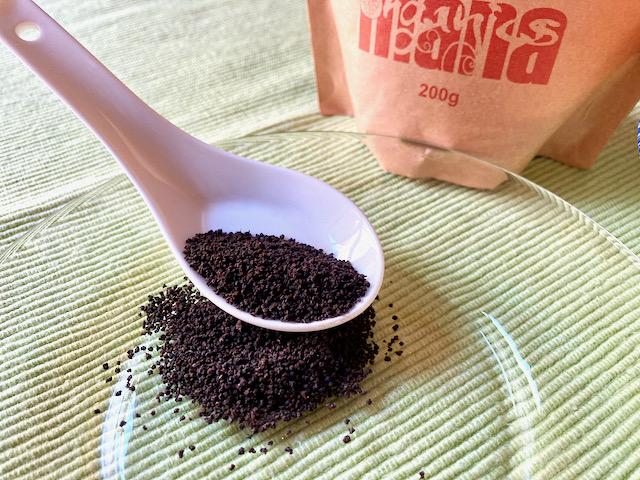
CTC stands for “cut, tear, curl” and is a processing method that causes deep oxidation of plant polyphenols. The result is a dark red tea with strength, briskness, and just enough astringency. Tea made the CTC way is rolled into tiny pellets that expand in hot water, so you’ll need a mesh strainer or French press to separate the leaves from the liquid.
On Mana’s packet are instructions for brewing milk tea. I followed the suggested ratio of water to milk (2:1) and settled on 1.5 tsp of tea pellets for every 1.5 cups of water and milk mixture. You get a flavorsome, lightly creamy brew that feels like you’re cheating on a sugar-free diet.
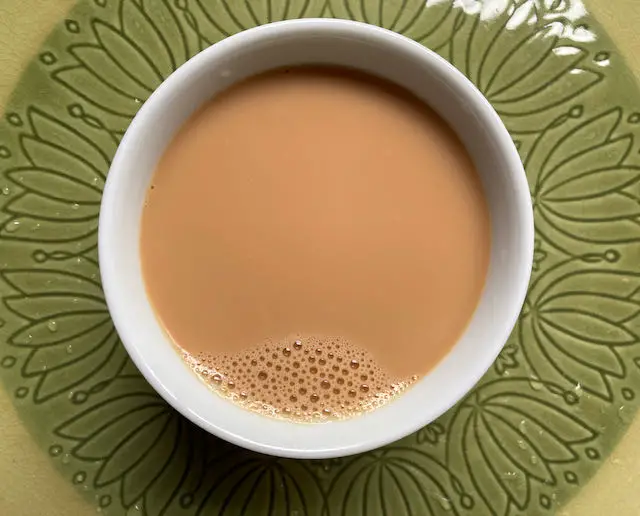
Others report that non-dairy milk made from almonds or oats also works with Assam CTC black tea. Some add table sugar to the mix, but I don’t find that adjustment necessary.
If I have one complaint: Mana Organics only offers one packet size of 7 ounces (200g). That sounds like a lot, but Mana’s CTC pellets are tiny, and I make strong brews with a lot of tea. However, Mana’s price per ounce is compelling, so I buy multiple packets.
If you want fewer packets to store, try another Assam black I have reviewed and enjoyed. The family-run enterprise at the Ghograjan Tea Estate grows its tea and processes an excellent CTC Assam black with milk. They offer one-pound packets and sometimes smaller quantities as well.
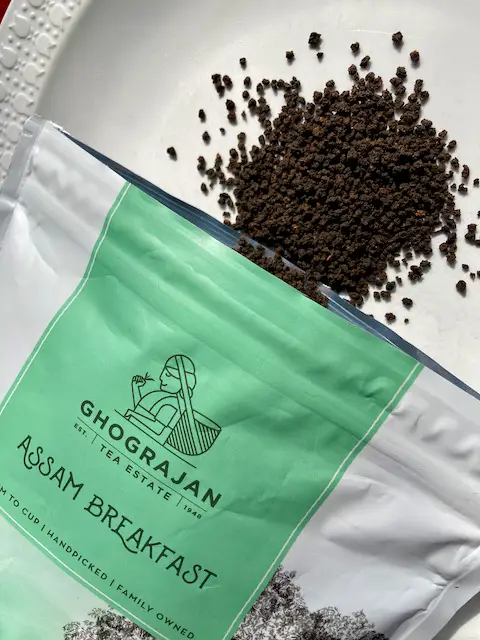
#4. Best Loose-leaf Tea for Iced Tea: Golden Monkey Black Tea from Organic Positively Tea
For many in the tea business, iced tea was our starter tea. It was served at most meals, including breakfast, and it was always made with bagged black tea. And because the tea was bitter-tasting, it was brewed with heavy sweetening. It was more like a syrup than a beverage.
Fortunately, you no longer have to dissolve a mound of table sugar into the tea pitcher. Instead, we can brew naturally sweet teas that don’t need sweeteners.
Golden Monkey Black Tea from Organic Positively Tea is my entry as the best loose-leaf tea to ice. Golden Monkey is carefully processed to hit the sweet spot in the tea plant Camellia sinensis. The flavor is sweet and savory, somewhat like a baked yam or lightly buttered bread, and with a robustness and strength that supports the tea through melting ice.
Preserving flavor and mouthfeel despite dilution and cooling is vital to a great iced tea!
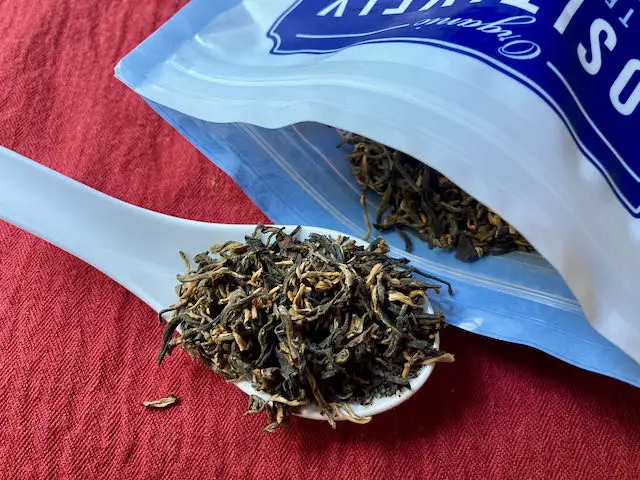
I understand the power of a bossy sweet tooth and that you might be tempted to add sugar to iced Golden Monkey. Remember, however, that a virtue of loose-leaf tea is that you can fine-tune the amount of leaves you steep.
So, instead of adding sugar, try deepening the flavor intensity by steeping more tea leaves per batch. With some trial and error, you might find that you’re looking for a robust iced tea rather than sweet tea syrup.
Of course, Positively’s teas are USDA-certified organic, so you have the confidence that you’re not drinking in residues of pesticides or herbicides.
If you drink a lot of iced tea, you’re probably looking for a bargain in loose-leaf. Try Golden Monkey Black Tea, sold by FullChea. I’ve enjoyed FullChea’s Golden Monkey both hot in a cup and iced in a tall glass, and they offer an excellent buy. My introduction to this brand’s tea was a serving of iced Golden Monkey offered by a friend. You’ll trade a tad of smoothness in mouthfeel for the price, but I don’t find it off-putting.
You can steep tea leaves floating loose in the tea pot, or you can put them in an fine-mesh infuser. Infusers can be more convenient during cleanup.
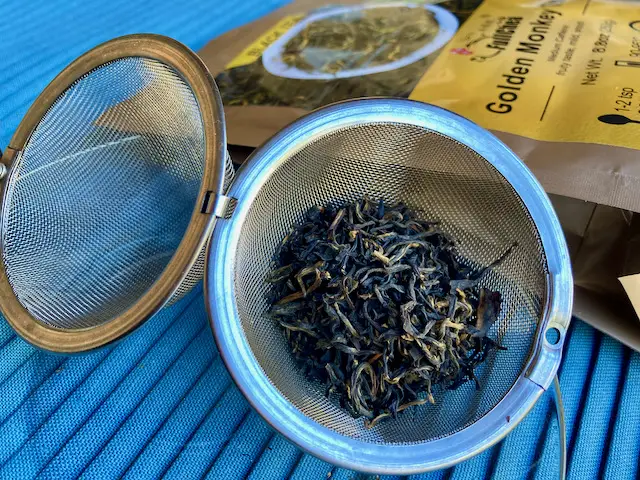
#5. Best Caffeine-free Loose-leaf Tea: Honeybush Tea from Davidson’s
When I want a break from caffeine, I turn to loose-leaf Honeybush tea.
Unlike the Camellia sinensis teas reviewed here, Honeybush is made from legume family plants that do not synthesize caffeine. Closely related to Rooibos tea, the distinct flavor of Honeybush emerges when the tiny leaves and stems are harvested, chopped, and oxidized under the hot sun of South Africa, where Honeybush is native.
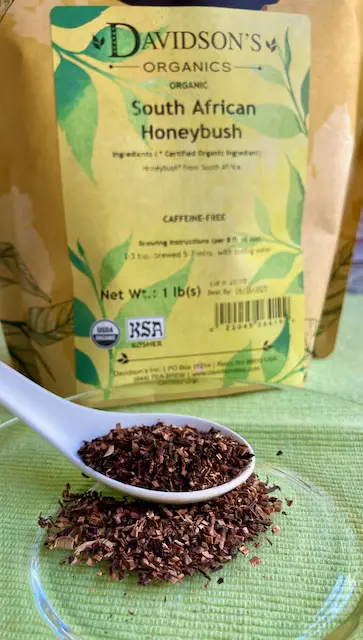
During Honeybush processing, a sweet, earthy note develops and is preserved during leaf drying. I steep a heaping tablespoon of tea in 6 oz (235 ml) of 200°F (93°C) water and experience a clean, crisp mouthfeel with a slightly resinous, perfumed finish. You almost think you’re drinking a camellia tea, but the sweetness of Honeybush is unusual and likes to waft through the nasal cavity.
And it’s great hot or iced, which makes Honeybush one of my favorite daily teas.

Davidson’s Organic Tea is a faithful supplier of quality teas worldwide and is my top choice in Honeybush because of its excellent flavor. It is also the least expensive tea on this list and a great value. A pound of Davidson’s Honeybush will last you a good while.
Check out Green Honeybush if you want a less oxidized tea with more antioxidants. It’s made from the same plant but has a lighter, more floral aroma than oxidized Honeybush, and of course, it is naturally caffeine-free.
#6. Best Loose-leaf Chai: Original Masala Chai from Vahdam Teas
If you order “chai tea” in America, you mean “spiced black tea.” However, chai, in the Indian language of Hindi, translates to “tea,” so “chai tai” is redundant. But for consistency within my home country, I’ll stick with chai tea and soldier on.
The spices and teas used to make chai can vary among tea manufacturers. The most basic or original recipe includes a robust black tea with cardamom, cinnamon, cloves, ginger, and peppercorns. In India, whole milk and table sugar are often mixed into hot chai, but many Americans prefer unaltered chai. I’ve been served chai with and without milk and sugar, which is a delight both ways.
Vahdam Teas is a seller of premium teas from India. Rapid turnaround from the tea factory to your doorstep is Vahdam’s value-add. Their Masala Chai is the original recipe with a CTC black tea that nicely balances maltiness with a complex spiciness unique to chai.
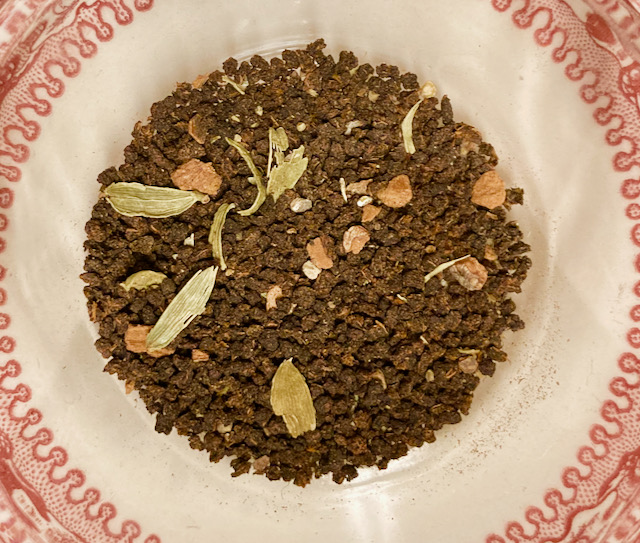
You can explore many variations of chai, but I recommend that beginners stick with the original Masala mix and work from there. I like Vahdam’s chai in the 2:1 water-to-milk ratio and 2 tsp of chai stirred in. For a more robust black tea component, I mix in more CTC black from one of the abovementioned sellers.
I get an instant flood of Holiday-themed, festive sensations from the first sip of Masala chai. It’s like Christmas morning in…June or any other month! This is a curious response since I have no experience in my past that would connect Holidays with chai, but it feels authentic in any case. I hope your experience with Vahdam’s chai is real, too!
Some tea drinkers may wish to blend chai spices at home. Vahdam Teas offers a large selection of prepared spices and seasonings to supply the DIYers. Ingredients ship in a convenient, resealable container to maintain freshness. Mix in one of the Assam teas I recommended earlier, and get creative with the blend that suits your tastes.
#7. Best Loose-leaf Oolong tea: Black Dragon Oolong from The Tao of Tea
Oolong is one of those teas people either love or hate. For me, it’s love because it comes in so many variations that when you tire of one style of oolong, you can move on to the next.
I recommend an oolong with earthy, toasty, and nutty notes for starting tea drinkers. Perhaps one with just a dash of floral as well. An intensely floral oolong reminiscent of green tea is worth sampling but can be difficult for some.
The Tao of Tea’s Black Dragon Oolong is a good starter tea that hits the nutty-robust part of the oolong flavor range. Tea leaves processed into oolong pass through many steps, including a resting/oxidation stage. This is where the Black Dragon develops its oxidized flavor tones that soothe the palate.

Black Dragon is packed in a lovely tin worthy of gift exchange. The tin has a decorative outer lid and a sealing interior lid that’s hard to remove. Grip the lip of the interior lid and pop it off, then inhale the pleasant fragrance of a fall forest after a gentle rain.
Oolong tea can be pricey in small quantities. If you want a bargain oolong with a similar flavor profile to Black Dragon, try Organic Positively Tea’s Qilan Oolong. You can get a pound for about half the price per ounce as the selection from The Tao of Tea. Its deep-woods, fireside-roasted quality is prominent, and I get several steepings with one batch. Positively recommends lower temps for water, but I like it on the hot side, around 195°F (90.5°C) for this oolong.
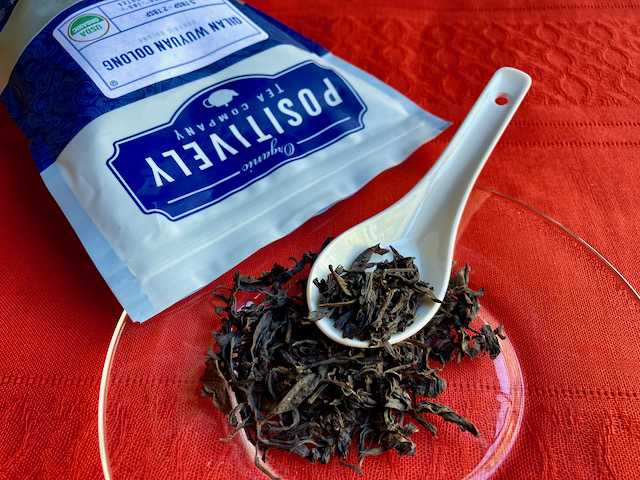
The Verdict: Best Loose-leaf Teas
FAQs
What Teaware Is Needed For Loose-leaf Tea?
If you’re new to loose-leaf tea, don’t fall for the line that it’s complicated to brew. It’s not!
Here’s all you need to get started:
And that’s it, all you need to brew loose-leaf tea. As you become more comfortable with drinking loose-leaf, you might upgrade your teaware to something that’s prettier or produces a better result. Just see how it goes before spending a lot of money on teware. Buying quality tea is a more important priority, in my opinion.
How Do You Brew Loose-leaf Tea?
Like most things, finding your happy space requires finding a balance. When preparing loose-leaf tea, the balance of factors is critical. Consider these factors as you learn to brew loose-leaf tea properly.
Water Temperature
Most manufacturers advise steeping tea in boiling water (212°F, 100°C), but they don’t tell you that a full boil can turn a good tea bad. Instead, experiment with a lower temp range, like 195–200°F (90–93°C). Work your way up to a full boil if you think a flavor or aroma is hiding in the tea and needs a nudge to express itself. You’ll also notice that water below boil is easier on your lips and mouth!
If you don’t have a heat-safe thermometer to check the water temperature, watch the bubbles in the kettle as it heats. You’ll learn when to stop heating based on the size of the bubbles.
Amount of Tea Leaves to Steep
Newbies make the mistake of not steeping enough tea leaves (or using too much water; same thing). If the tea flavor isn’t deep enough, use more leaves in the next batch while keeping the amount of water the same.
Steeping Duration
You have a lot of flexibility with steeping duration, but I do pay attention to the manufacturer’s recommendations here. For instance, if they advise short steeps, like 45 seconds, you have a delicate or complex tea. In contrast, if they suggest a wide range, like 3 to 5 minutes, it’s harder to over-steep. Regardless, you should use more tea leaves before steeping longer to bring out depth and flavor.
Number of Steepings
One benefit of brewing loose-leaf tea is that you can, with some teas, steep a batch more than once. You might find, to your delight, that the character of the tea improves with each steeping. You’ll have to experiment with water temperature, leaf amount/volume, and steeping duration to find the combination that yields the most enjoyable tea. And that’s part of the fun!
Loose-leaf vs. Tea Bag: What’s the Real Difference?
If you cut open an ordinary tea bag, you’ll see it contains leaf bits or dust-sized particles. Believe it or not, this stuff started in the tea plantation as whole leaves and stems. After harvest, it went to the factory, got processed by various machines, and eventually packed into tea bags for the cup (I skipped a few details, but that’s the jist of it).
Teas marketed as loose-leaf, in contrast, are larger processed pieces, maybe even whole leaves attached to plant stems. The material that ends up in tea bags is often the by-product of manufacturing whole leaves and stems; in some cases, it’s just dust.
In any case, leaf size is the main distinction between loose and bagged, and it matters for at least two reasons.
First, loose-leaf teas are usually twisted, reshaped, and dried during processing. If the leaves haven’t been broken too severely, their natural form as a whole leaf will be restored while steeping in hot water. Observing tea reconstitute and gradually releasing beautifully colored extract is part of the joy of drinking loose-leaf tea. For instance, black tea made from Camellia sinensis turns water amber-colored or dark brown.
The second charm of loose-leaf follows from the first. As tea steeps, amino acids, oxidized polyphenols, and starches are extracted from the leaf. These are the compounds that give tea its flavor and mouthfeel. In tea bags, the flavor elements are extracted faster than whole leaves, which have less surface area relative to the total volume of the leaf.
So, instead of getting a slow release from large leaf pieces, bagged tea dumps everything quickly into the water. The tea drinker will notice the “loudest” flavor above all others, while in loose-leaf, there’s more opportunity for the quiet flavor notes to get a hearing.
Mike grows and crafts tea in North Florida, USA. He has advanced degrees in biology, and has undertaken coursework in manufacturing Camellia sinensis teas. Mike is a member of the US League of Tea Growers (USLTG) and has presented invited talks on tea growing. Send him a note through our Contact Page if you'd like to talk about tea.









